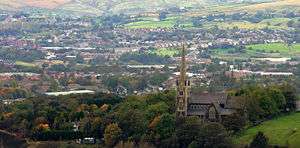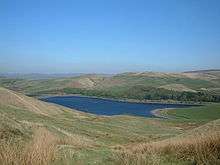Milnrow
| Milnrow | |
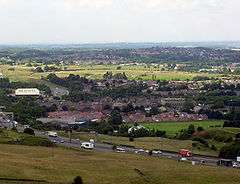 Milnrow and the M62 motorway |
|
 Milnrow |
|
| Population | 13,061 (2011 Census) |
|---|---|
| OS grid reference | SD926126 |
| – London | 168 mi (270 km) SSE |
| Metropolitan borough | Rochdale |
| Metropolitan county | Greater Manchester |
| Region | North West |
| Country | England |
| Sovereign state | United Kingdom |
| Post town | ROCHDALE |
| Postcode district | OL16 |
| Dialling code | 01706 |
| Police | Greater Manchester |
| Fire | Greater Manchester |
| Ambulance | North West |
| EU Parliament | North West England |
| UK Parliament | Rochdale |
|
|
Coordinates: 53°36′36″N 2°06′40″W / 53.6101°N 2.1111°W
Milnrow (pop. 13,062 (2011))[1] is a suburban town within the Metropolitan Borough of Rochdale, in Greater Manchester, England.[2][3][4] It lies on the River Beal at the foothills of the South Pennines, and forms a continuous urban area with Rochdale. It is 1.9 miles (3.1 km) east of Rochdale's town centre, 10.4 miles (16.7 km) north-northeast of the city of Manchester, and spans urban, suburban and rural locations—from Windy Hill in the east through to the Rochdale Canal in the west. Milnrow includes the villages of Tunshill and Newhey,[5] and is adjacent to junction 21 of the M62 motorway.
Historically a part of Lancashire, Milnrow during the Middle Ages was a hamlet located within the township of Butterworth and parish of Rochdale. It was named by the Anglo-Saxons, but the Norman conquest of England resulted in its ownership by minor Norman families, such as the Schofields and Cleggs. In the 15th century, the descendants of these families successfully agitated for a chapel of ease to be constructed in Milnrow by the banks of the River Beal, triggering its development as the main settlement in Butterworth. Despite this distinction, Milnrow did not increase much further in size or population until the dawn of the woollen trade in the Late Middle Ages.
To supplement their income, the inhabitants of Milnrow entered the domestic system, producing flannel and woollen cloth in purpose-built weavers' cottages, some of which from the Early Modern period have survived as listed buildings.[6] Coalmining and metalworking also flourished in this period, but the Industrial Revolution supplanted the domestic industries and converted Milnrow into an urban mill town that mass-produced textile goods in cotton mills, such as Ellenroad Ring Mill (now a museum). The Milnrow Urban District was established in 1894 and was governed thereafter by its own district council until its abolition in 1974.
Milnrow has been described as "the centre of the south Lancashire dialect".[7] John Collier (who wrote under the pseudonym of Tim Bobbin) was an acclaimed 18th-century caricaturist and satirical poet from Milnrow who wrote in a broad Lancashire dialect. Rochdale-born poet Edwin Waugh was influenced by Collier's work, and wrote an extensive account of Milnrow during the mid-19th century in a tribute to Collier.[8] Although Milnrow's heavy textile industries declined during the mid-20th century, the town has continued to grow as a result of suburbanisation, urban renewal and its immediate proximity to road, rail and motorway networks.
History
Neolithic human activity in Milnrow is evidenced with an ancient stone axe found at Hollingworth.[9] Bronze and Iron Age peoples left thousands of flint tools which have been found on the moorland surrounding Milnrow, including a stone hammer found at Low Hill in 1879.[10] Low Hill was the site of an ancient burial mound where a funerary urn was found. A small Roman statue of the goddess Victory was discovered at Tunshill Farm in 1793.[11] During excavations at Piethorne Reservoir in the mid-18th century, a Celtic spear-head with a 5-inch (130 mm) blade was unearthed, implying human habitation in the locality during the British Iron Age.[12] Toponymic evidence implies the presence of the Anglo-Saxons and Norsemen in the locality,[13] and inscribed stones discovered in 1986 at Lowhouse Farm, one of which has Latin text, suggest the existence of a 9th-century Anglo-monastic site, or of a Viking-Age literate community from Milnrow, Rochdale or the surrounding region.[14]
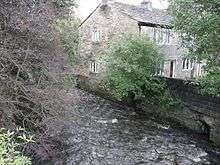
The name Milnrow is derived from Old English,[2] but its meaning has not been deciphered with any certainty. The name may be a corruption of an old pronunciation of "Millner Howe", a water driven corn mill at a place called Mill Hill on the River Beal that was mentioned in deeds dating from 1568.[5][15][16] Another explanation is that it means a "mill with a row of houses", combining the Old English elements myne and raw.[2] Others have suggested that the name "Milnrow" is derived from a local family with the surname Milne, who owned a row of houses in the locality. A map from 1292 shows "Milnehouses" at Milnrow's present location, other spellings have included "Mylnerowe" (1545) and "Milneraw" (1577).[15][16]
Milnrow emerged as a settlement after the Norman conquest of England in 1066; the Norman families of "de Butterworths", "de Turnaghs", "de Schofields", "de Birchinleghs", "de Wylds" and "Cleggs" controlled the lands which formed the township of Butterworth from which Milnrow evolved as its main settlement.[15][17] In addition to the chapelry of Milnrow, Butterworth encompassed the hamlets of Clegg, Wildhouse, Belfield, Butterworth Hall, Lowhouse, Newhey, Ogden, Tunshill, Haughs, and Bleaked-gate-cum-Roughbank.[18] Butterworth was linked, ecclesiastically, with the parish of Rochdale.
During the Middle Ages, the small, scattered community in and around Milnrow was primarily agrarian, with the growing and milling of grain and cereal being the main labour of the people.[5][19] Dry ironstone smelting was introduced into Milnrow at a very early time as evidenced from ancient kilns found at Tunshill.[19] A chantry was constructed in the year 1400 by the Byrons—the then Lords of the Manor—and a chapel for the wider community in 1496;[20][21] A document dated 20 March 1496, during the reign of Henry VII, proclaims that open land by the River Beal would be the site of the new chapel.[21]
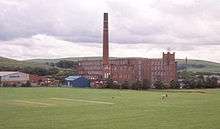
Legal documents dated 1624 state that Milnrow consisted of six cottages; there were a further nine at Butterworth Hall, and three at Ogden.[22] Milnrow did not expand until the introduction of a woollen weaving trade which began in the Late Middle Ages and continued until the 19th century.[23][24] During this time nearby Rochdale—the local market town—was used as a central marketing, finishing and fellmongering hub.[23] The handloom weaving of woollen cloth and flannels in the domestic system became the staple industry of Milnrow, facilitating the community's growth and prosperity.[25] Between 40,000 and 50,000 sheep skins were needed every week to provide for Milnrow's industries,[26] and as early as the 16th century, the demand for wool was so great it had outstripped the local supply of the region and had to be imported from Ireland and the English Midlands.[23] As a consequence of the woollen trade, rows of "fine stone domestic workshops" or weavers' cottages were constructed beyond Milnrow's original core, with dwelling quarters on the lower floors and loom-shops on the top floor.[23][27]
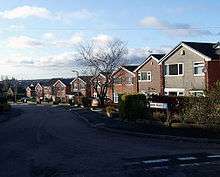
With the onset of the Industrial Revolution, the River Beal was used to power large weaving mills.[24] Within one generation during the late-19th century,[24] and following a boom in nearby Oldham, Milnrow's staple industry changed from wool weaving to cotton spinning.[24][28] Soon, distinctive rectangular brick-built mills dominated Milnrow's landscape.[29] Milnrow, the location of some of the earliest ring spinning companies, had many of the characteristics of a company town. The Heaps of Milnrow exercised significant deferential and political influence in the local area.[30] Following the Great Depression, the region's textile sector experienced a decline until its eventual demise in the mid-20th century. Milnrow's last cotton mill was Butterworth Hall Mill, demolished in the late 1990s.[31] Milnrow experienced population growth and suburbanisation in the second half of the 20th century, spurred by the construction of the M62 motorway through the area, making Greater Manchester and West Yorkshire commutable.[24][32] Milnrow Metrolink station opened as part of Greater Manchester's light-rail Metrolink network on 28 February 2013.[33]
Governance
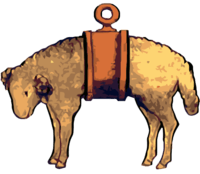
Lying within the historic county boundaries of Lancashire since the early 12th century, Milnrow was a chapelry and component area of Butterworth, an ancient township within the parish of Rochdale and hundred of Salford.[4] Under feudalism, Butterworth was governed by a number of ruling families, including the Byrons, who obtained the title of Lords of the Manor.[21] Throughout the Late Middle Ages, local men acted as jurors and constables for the purposes of upholding law and order in Butterworth. Butterworth in the 19th century constituted a civil parish, until its dissolution in 1894.[4]
Milnrow's first local authority was a Local board of health established in 1870.[4] Milnrow Local Board of Health was a regulatory body responsible for standards of hygiene and sanitation in the wards of Belfield, Haugh and Milnrow.[22] In 1879, a part of Castleton and another part of Butterworth were included in the area of the Local board. Under the Local Government Act 1894, the area of the local board broadly became the Milnrow Urban District, a local government district in the Rochdale Poor Law Union and administrative county of Lancashire.[4] Under the Local Government Act 1972, the Milnrow Urban District was abolished, and Milnrow has, since 1 April 1974, formed an unparished area of the Metropolitan Borough of Rochdale, within the metropolitan county of Greater Manchester.[4] In anticipation of the new local government arrangement, Milnrow Urban District Council applied for successor parish status to be granted to the locality after 1974, but the application was not successful.[36]
From 1983 to 1997, Milnrow was represented in the House of Commons as part of the parliamentary constituency of Littleborough and Saddleworth. Between 1997 and 2010 it was within the boundaries of Oldham East and Saddleworth.[37] In 2010 Milnrow became part of the Rochdale constituency, which is represented by Simon Danczuk MP, a member of the Labour Party.
Geography
At 53°36′36″N 2°6′40″W / 53.61000°N 2.11111°W (53.6101°, −2.1111°), and 168 miles (270 km) north-northwest of central London, Milnrow stands roughly 830 feet (253 m) above sea level,[38] on the western slopes of the Pennines, 10.4 miles (16.7 km) north-northeast of Manchester city centre, in the valley of the River Beal. Blackstone Edge and West Yorkshire are to the east; Rochdale and Shaw and Crompton are to the west and south respectively. Milnrow, considered as the area covered by the former Milnrow Urban District Council, extends over 8.1 square miles (21 km2).[39]
The River Beal, a tributary of the River Roch, runs centrally through Milnrow from the south through Newhey.[39] The soil is light gravel and clay, with subsoil of rough gravel,[40] and the local geology is carboniferous coal measures. Milnrow's highest point (1,310 feet or 399 metres) is by its east-southeastern border with the Metropolitan Borough of Oldham at Denshaw and Bleakedgate Moor, above the rugged, upland Piethorne Valley and close to Windy Hill. From this point the average height of the land falls gradually towards the direction of Rochdale to the northwest, into a mixture of undulating farmland and suburbia.[24][41] Milnrow experiences a temperate maritime climate, like much of the British Isles, with relatively cool summers and mild winters. There is regular but generally light precipitation throughout the year.
 |
Wardle | Littleborough | Blackstone Edge |  |
| Rochdale | |
Piethorne Valley | ||
| ||||
| | ||||
| Thornham | Shaw and Crompton | Newhey |
In 1855, the poet Edwin Waugh said of Milnow:
Milnrow lies on the ground not unlike a tall tree laid lengthwise, in a valley, by a riverside. At the bridge, its roots spread themselves in clots and fibrous shoots, in all directions; while the almost branchless trunk runs up, with a little bend, above half a mile towards Oldham, where it again spreads itself out in an umbrageous way.[8]— Edwin Waugh, Sketches of Lancashire life and localities (1855)
Surrounded by open moor and grassland on its northern and eastern sides, Milnrow forms a continuous urban area with neighbouring Rochdale to the west, and, according to the Office for National Statistics, is part of the Greater Manchester Urban Area, the United Kingdom's third largest conurbation.[42]
There are a number of small named-places in and around Milnrow, including Clegg, Firgrove, Gallows, Haugh, Newhey, Kitcliffe, Ogden, and Tunshill. Newhey, at the south of Milnrow by Shaw and Crompton, is the most distinct of these areas, and, with its own parish church and Metrolink station, is invariably given as a separate village. The Gallows public house is said to occupy the land of an ancient execution site; Gallows, a former hamlet at northeastern Milnrow, is named in reference to a baronial gallows.[5][19][43] Kitcliffe, Ogden and Tunshill, to the east of central Milnrow, are hamlets that occupy the upper, mid and lower Piethorne Valley respectively.
Demography
According to the Office for National Statistics, at the time of the United Kingdom Census 2001, Milnrow (urban-core and sub-area) had a total resident population of 12,541.[44] The electoral ward of Milnrow (which has different boundaries) had a population of 11,561.[45] Merriam-Webster's Geographical Dictionary (2007) estimated Milnrow's population to be 12,800 in 2001.[3]
Of the residents in the electoral ward of Milnrow, which includes Newhey and the Piethorne Valley, 40.8% were married, 10.3% were cohabiting couples, and 9.5% were lone parent families. Twenty-seven percent of households were made up of individuals and 13% had someone living alone at pensionable age.[46] The ethnicity of the community was given as 98% white, 0.7% mixed race, 0.8% Asian, 0.2% black and 0.3% Chinese or other.[47] The place of birth of the town's residents was 97% United Kingdom (including 95.04% from England), 0.6% Republic of Ireland, 0.5% from other European Union countries, and 2.6% from elsewhere in the world.[48] Religion was recorded as 80% Christian, 0.8% Muslim, 0.1% Hindu, 0.1% Buddhist, and 0.1% Jewish. Some 12.2% were recorded as having no religion, 0.2% had an alternative religion, and 6.1% did not state their religion.[49] Historically, in addition to the established church, Nonconformism – particularly Wesleyanism – was a branch of Christian theology practised in Milnrow by a significant part of the local population.[50]
The economic activity of residents aged 16–74 was 45% in full-time employment, 12% in part-time employment, 7.7% self-employed, 2.6% unemployed, 2.1% students with jobs, 3.1% students without jobs, 13% retired, 4.6% looking after home or family, 7.4% permanently sick or disabled, and 2.3% economically inactive for other reasons. This was roughly in line with the national figures.[51]
| Year | 1901 | 1911 | 1921 | 1931 | 1939 | 1951 | 1961 | 1971 | 2001 | 2011 | |||
|---|---|---|---|---|---|---|---|---|---|---|---|---|---|
| Population | 8,241 | 8,584 | 8,390 | 8,623 | 8,265 | 8,587 | 8,129 | 10,345 | 12,541 | 13,061 | |||
| Source:A Vision of Britain through Time | |||||||||||||
Economy

Prior to deindustrialisation in the late-20th century, Milnrow's economy was linked closely with a spinning and weaving tradition which had evolved from developments in textile manufacture during the Industrial Revolution. Industries ancillary to textile production were also operational, such as coal mining at Tunshill,[23] and metalworking at Butterworth Hall.[52] Butterworth Hall Colliery was the largest colliery in the Rochdale region, employing around 300 men in 1912.[53] Modern sectors in the area include engineering, packaging materials, the dyeing and finishing of textiles and carpets, and ink production.[54] The main street comprises a variety of shops, restaurants and food outlets.
The biggest employers are Holroyd Machine Tools, part of Precision Technologies Group who have been based in the town since they moved from Manchester to Milnrow in 1896.[55] In the early 20th century they operated a foundry in Whitehall Street and employed engineers and apprentices.[55] As of 2006 Holroyd had a workforce of 160, but its parent company Renold PLC employs a further 200 people at a base in there.[56][57][58] Global industrial and consumer packaging company Sonoco operate a warehouse in the town.[59] Over half-a-million units of local delicacy Rag Pudding is mass-produced by Jackson's Farm Fayre in their Milnrow factory.[60] In Newhey, Sun Chemical produce printer inks and supplies,[61] and Newhey Carpets design and produce carpets.[62] At Ogden, textiles are dyed and finished by PW Greenhalgh.[63]
Kingsway Business Park will be a 420-acre (1.7 km2) "business-focused, mixed use development" occupying land between Milnrow and Rochdale, adjacent to junction 21 of the M62 motorway; it is expected to employ 7,250 people directly and 1,750 people indirectly by around 2020.[64] Tenants on the park include JD Sports and Wincanton plc.[65] Kingsway Metrolink station is a stop built as part of Phase 3a of Metrolink's expansion, and serves Kingsway Business Park.[66]
Landmarks
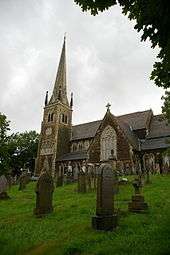
The Grade II listed Church of St James, Milnrow's Anglican parish church, was built in 1869 and is dedicated to James the Apostle.[67] It is part of the Church of England and lies within the Diocese of Manchester.[68] The origins of the church can be traced to a chantry built by the Byrons in the year 1400. When that baronial family moved from Milnrow to another of their homes following the Wars of the Roses, the local population was left without a place of worship and a chapel was constructed by the River Beal to serve this community.[21] This structure existed until the 1790s, when a "poorly designed" chapel was erected and consecrated; however, due to structural weaknesses, that church was demolished in 1814.[21] Following an interim period when a "plain building" was used for worship, the present church building was built and consecrated by the Bishop of Manchester on 21 August 1869.[69]
Described as "by far the most distinctive and splendid building in the district",[69] the neo-Gothic Newhey, St Thomas parish church was built in 1876 and served a new Anglican parish of Newhey created in the same year.[70] Dedicated to Thomas the Apostle, it is part of the Church of England, and its patron is the Bishop of Manchester.[71] The church was extensively damaged in an arson attack on 21 December 2007.[72]
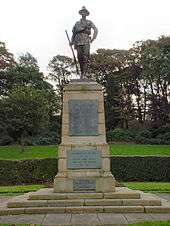
Milnrow War Memorial is located in Memorial Park at Newhey, and is a Grade II listed structure.[73] The war memorial was originally sited in central Milnrow, set back from the road near Milnrow Bridge, and was unveiled on 3 August 1924 by Major General A. Solly-Flood, a former commander of 42nd (East Lancashire) Division. The memorial is constructed of sandstone surmounted by a bronze statue of a World War I infantry soldier with rifle and fixed bayonet symbolic of the young manhood of the district in the early days of World War I. In selecting the design the Milnrow War Memorial Committee was influenced by the statue unveiled at Waterhead in Oldham; the work of George Thomas. Thomas sculpted Milnrow's memorial in 1923. The plinth holds bronze and slate panels recording the names of those who died in the two World Wars.[74][75]
Clegg Hall is a 17th-century hall and Grade II* listed building situated in green space between Milnrow, Rochdale and Littleborough.[76][77] It was constructed in about 1610 for Theophilus Aston and may have been built on the site of a mediaeval house and inn.[76]
In Newhey is the Ellenroad Steam Museum, the retained engine house, boiler house, chimney and steam engine of Ellenroad Mill, a former 1892-built cotton mill designed by Sir Philip Stott, 1st Baronet. Now operated as an industrial heritage centre, the mill itself is no longer standing, but the steam engine (the world's largest working steam mill engine)[78] is maintained and steamed once a month by the Ellenroad Trust.[79] The museum has the only fully working cotton mill engine with its original steam-raising plant in the world.[80] Ellenroad Mill produced fine cotton yarn using mule spinning.[78]
Hollingworth Lake lies beyond Milnrow, by Littleborough and is part of a local country park. It was built in 1801 as a feeder reservoir for the Rochdale Canal, but it soon became a tourist destination for local people during their leisure time.[81] The lake covers an area of 130 acres (0.53 km2) and the path around it originally measured 2.5 miles (4.0 km).
Transport
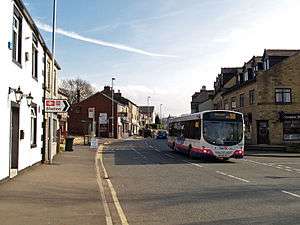
Public transport in Milnrow is co-ordinated by Transport for Greater Manchester, and services include bus and rail transport. Major A roads link Milnrow with other settlements, including the A640 road, which forms a route from Rochdale and over the Pennines into Huddersfield and West Yorkshire.
Milnrow Metrolink station is on the Oldham and Rochdale Line with tram services operating every 12 minutes. It was previously a railway station on the Oldham Loop Line which connected Manchester, Oldham and Rochdale.[24] The station was constructed in 1862 by navvies drafted by contractors under the Lancashire and Yorkshire Railway. On 12 August 1863, the line was opened to commercial traffic and 2 November 1863, to passenger trains.[82] Milnrow station was originally staffed, and the line through it was dual-track; however this section was reduced to single-track in 1980.[82] Milnrow railway station closed on 3 October 2009 to be converted for use with an expanded Metrolink network.[83][84] The station reopened on 28 February 2013 as Milnrow Metrolink station; also opening at this time in the Milnrow area was Kingsway Metrolink station and Newhey Metrolink station.[33]
Milnrow is situated at Junction 21 of the trans-Pennine M62 motorway. Construction of the Milnrow part of the M62 began in April 1967,[85] a process which spread mud and dirt throughout the town.[32] The official opening of the motorway on 13 October 1971 was by Queen Elizabeth II, who was welcomed by Ralph Assheton, 1st Baron Clitheroe in his role as Lord Lieutenant of Lancashire, as well as the Chairman of Milnrow Urban District Council and his wife.[32] Once opened, the Queen cast aside protocol for an informal meeting with the people of Milnrow.[32]
The Rochdale Canal—one of the major navigable broad canals of Great Britain—passes along Milnrow's north-western boundary which divides it from the village of Wardle and districts of Belfield and Castleton in Rochdale.[86] The Rochdale Canal was historically used as a highway of commerce for the haulage of cotton, wool, and coal to and from the area.
Bus services 58, 181 and 182 operate to Rochdale, Newhey, Oldham, and Manchester, while services 451 and 462 serve Rochdale and the estates of Milnrow and Newhey, operated by First Greater Manchester, Rosso and Manchester Community Transport[87]
Education
The Free School of Milnrow was founded in 1726. From 1739 until his death in 1786 the schoolmaster was the caricaturist John Collier.[40] Newhey Council School was constructed in 1911.[88] Milnrow St James School evolved into the modern primary school, Milnrow Parish Church of England Primary.[89] It is a denominational school with the Church of England, linked with Milnrow's Anglican parish church, St James's. There are further primary schools, in central Milnrow named Moorhouse County Primary and Crossgates County Primary, and at Newhey named Newhey Community Primary, all of which are non-denominational.[90][91] Hollingworth Academy (formerly Roch Valley High then Hollingworth High and then Hollingworth Business and Enterprise College) is a secondary school in Milnrow.[92] It is a co-educational school of non-denominational religion.[93] Other learning facilities in Milnrow include a 1907-built Carnegie library.[41]
Sports
Milnrow C.C. is a cricket club based at Ladyhouse in Milnrow, and which has played in the Central Lancashire Cricket League since its foundation in 1892. Milnrow C.C. formed in 1857 from a group of local businessmen who felt the district deserved its own distinct team. Members of the club were recruited and teams were selected to play other clubs in the surrounding townships.[94]
The Soccer Village consists of four indoor pitches in an arena with grandstand spectator seating for 300.[95] It is used for casual, amateur and organised leagues and tournaments.
There has been a golf course at Tunshill since 1901.[96] It is affiliated with the English Golf Union.
New Milnrow and Newhey Rugby League Club is the local Rugby league team.
Public services
Home Office policing in Milnrow is provided by the Greater Manchester Police. The force's "(P) Division" have their headquarters for policing the Metropolitan Borough of Rochdale in Rochdale and the nearest police station is at Littleborough to the north.[97] Statutory emergency fire and rescue service is provided by the Greater Manchester Fire and Rescue Service, which has one station in Rochdale on Maclure Road.[98]
There are no hospitals in Milnrow—the nearest are in the larger settlements of Oldham and Rochdale. The Rochdale Infirmary in north-central Rochdale and Birch Hill Hospital near the villages of Wardle and Littleborough, are NHS hospitals administrated by Pennine Acute Hospitals NHS Trust. Birch Hill occupies the former Rochdale Union Workhouse at Dearnley.[99] The North West Ambulance Service provides emergency patient transport.
Waste management is co-ordinated by the local authority via the Greater Manchester Waste Disposal Authority.[100] Milnrow's Distribution Network Operator for electricity is United Utilities;[101] there are no power stations in the area, but a Wind farm exists on Scout Moor which consists of 26 turbines on the high moors between Rawtenstall and Rochdale, generating 65MW of electricity.[102] United Utilities also manages Milnrow's drinking and waste water;[101] water supplies are sourced from several local reservoirs, including Kitcliffe, Piethorne and Rooden in Milnrow's outlying moorland between Newhey and Denshaw.[101]
Notable people
John Collier (who wrote under the pseudonym of Tim Bobbin) was an acclaimed 18th-century caricaturist and satirical poet who was raised and spent all his adult life in Milnrow. Born in Urmston in 1708, Collier was schoolmaster for Milnrow. Inspired by William Hogarth, Collier's work savagely lampooned the behaviour of upper and lower classes alike, and was written in a strong Lancashire dialect.[103] Many of his works and personal possessions are preserved in Milnrow's library,[104] and he is commemorated in the name of a "prominent pub" in central Milnrow.[24] Francis Robert Raines (1805–1878) was the Anglican vicar of Milnrow, and an antiquary. He edited 23 volumes for the Chetham Society publications.[105] He was ordained in 1828 and, after short appointments at Saddleworth and Rochdale, he was vicar at Milnrow for the rest of his life.[105] John Milne was a professor, geologist and mining engineer who invented a pioneering seismograph (known as the Milne-Shaw seismograph) to detect and measure earthquakes. Although born in Liverpool in 1850 owing to a brief visit there by his parents, Milne was raised in Rochdale and at Tunshill in Milnrow.[106][107] Other notable people of Milnrow include Lizzy Bardsley, who, in 2003, gained fame from appearing on Channel 4's Wife Swap,[108][109] and Newhey-raised Stuart Bithell, who won a Silver Medal in the Men's 470 class at the 2012 Summer Olympics.[110]
References
Notes
- ↑ "Town population 2011". Retrieved 7 January 2016.
- 1 2 3 "Milnrow". Brewer's Britain and Ireland. credoreference.com. 2005. Retrieved 11 April 2010.
A former cotton town in Greater Manchester
(subscription required) - 1 2 "Miln•row". Merriam-Webster's Geographical Dictionary. credoreference.com. 2007. Retrieved 11 April 2010.
Town, Greater Manchester, NW England, SE suburb of Rochdale; pop. (2001e) 12,800.
(subscription required) - 1 2 3 4 5 6 "Greater Manchester Gazetteer". Greater Manchester County Record Office. Places names – M to N. Retrieved 20 June 2007.
- 1 2 3 4 Rochdale Metropolitan Borough Council (N.D.), p. 32.
- ↑ Frangopulo (1977), p. 149.
- ↑ Joyce (1993), p. 198.
- 1 2 Waugh, Edwin (1855). Sketches of Lancashire life and localities. James Galt. p. 61.
- ↑ Historic England. "Monument No. 45988". PastScape. Retrieved 25 April 2008.
- ↑ Poole, S. (1986). "A Late Mesolithic and Early Bronze Age Site at Piethorn Brook, Milnrow". Greater Manchester Archaeological Journal. 2: 11–30.
- ↑ Historic England. "Monument No. 46071". PastScape. Retrieved 23 April 2008.
- ↑ Bateson 1949, p. 3
- ↑ March, Henry Colley (1880). East Lancashire Nomenclature and Rochdale Names. London: Simpkin & Co. ASIN B0014M51VQ.
- ↑ Oakden, Vanessa (2012). "A Pre-Conquest Latin Inscription from North-West England".
- 1 2 3 Hignett (1991), p. 2.
- 1 2 Ekwall (1972), p. 56.
- ↑ Manchester City Council. "Rochdale Towns". spinningtheweb.org.uk. Retrieved 20 April 2008.
- ↑ "Descriptive Gazetteer entry for Butterworth". visionofbritain.org.uk. Retrieved 22 April 2008.
- 1 2 3 Hignett (1991), p. 3.
- ↑ Rochdale Boroughwide Cultural Trust. "Events in Milnrow 1400–1929!". link4link.org. Retrieved 22 April 2008.
- 1 2 3 4 5 Hignett (1991), p. 32.
- 1 2 Fishwick 1889, p. 122.
- 1 2 3 4 5 McNeil, R. & Nevell, M. (2000), p. 35.
- 1 2 3 4 5 6 7 8 Rochdale Metropolitan Borough Council 1985, p. 33.
- ↑ Fishwick 1889, p. 54.
- ↑ Hignett (1991), p. 10.
- ↑ Frangopulo (1977), p. 29.
- ↑ Hignett (1991), p. 11.
- ↑ Sellers (1991), p. 47.
- ↑ Procter, S. & Toms, S. (2000). "Industrial Relations and Technical Change: Profits, Wages and Costs in the Lancashire Cotton Industry, 1880–1914" (PDF). eprints.whiterose.ac.uk. Retrieved 29 April 2008.
- ↑ "This is Milnrow: Industry". milnrow-village.freeserve.co.uk. Retrieved 18 June 2008.
- 1 2 3 4 Hignett (1991), p. 35.
- 1 2 "Rochdale extension to Metrolink tram network opens". bbc.co.uk. 28 February 2013. Retrieved 2 March 2013.
- ↑ Gladstone City Council. "Mission, logo and Crest". gladstone.qld.gov.au. Archived from the original on 29 May 2008. Retrieved 16 June 2008.
- ↑ Rochdale Metropolitan Borough Council (N.D.), p. 19.
- ↑ Clark 1973, p. 106.
- ↑ Rochdale Metropolitan Borough Council. "Local MPs and MEPs – information and advice". rochdale.gov.uk. Retrieved 22 April 2008.
- ↑ "Milnrow, United Kingdom". Global Gazetteer, Version 2.1. Falling Rain Genomics, Inc. Retrieved 2 January 2008.
- 1 2 Hignett (1991), p. 6.
- 1 2 Brownbill, J; William Farrer (1911). A History of the County of Lancaster: Volume 5. Victoria County History. pp. 213–222. ISBN 978-0-7129-1055-2.
- 1 2 Hignett (1991), p. 7.
- ↑ Office for National Statistics (2001). "Census 2001:Key Statistics for urban areas in the North; Map 3" (PDF). statistics.gov.uk. Retrieved 22 April 2008.
- ↑ Lewis (1848), pp. 729–733.
- ↑ Office for National Statistics. "Greater Manchester Urban Area". statistics.gov.uk. Retrieved 25 April 2008.
- ↑ United Kingdom Census 2001 (2001). "Milnrow (Ward)". neighbourhood.statistics.gov.uk. Retrieved 28 April 2008.
- ↑ United Kingdom Census 2001 (2001). "Milnrow (Ward): Household Composition". neighbourhood.statistics.gov.uk. Retrieved 3 May 2008.
- ↑ United Kingdom Census 2001 (2001). "Milnrow (Ward): Ethnic Group". neighbourhood.statistics.gov.uk. Retrieved 3 May 2008.
- ↑ United Kingdom Census 2001 (2001). "Milnrow (Ward): Country of Birth". neighbourhood.statistics.gov.uk. Retrieved 3 May 2008.
- ↑ United Kingdom Census 2001 (2001). "Milnrow (Ward): Lead Key Figures". neighbourhood.statistics.gov.uk. Retrieved 3 May 2008.
- ↑ Hignett (1991), p. 34.
- ↑ United Kingdom Census 2001 (2001). "Milnrow (Ward): Economic Activity". neighbourhood.statistics.gov.uk. Retrieved 3 May 2008.
- ↑ Godman 1996, p. 63.
- ↑ Godman 1996, p. 59.
- ↑ Rochdale Boroughwide Cultural Trust. "Milnrow & Newhey". link4life.org. Retrieved 10 June 2008.
- 1 2 Godman 1996, p. 62.
- ↑ Foster, Stephen (4 July 2006). "Buyers are all set to move in on company". rochdaleobserver.co.uk. Retrieved 22 April 2008.
- ↑ Anon (20 March 2006). "In gear for good news story still on the run". rochdaleobserver.co.uk. Archived from the original on 28 August 2008. Retrieved 22 April 2008.
- ↑ "Renold Gears, Rochdale". renold.com. 2004. Retrieved 29 April 2003.
- ↑ Sonoco Products. "Sonoco Locations". sonoco.com. Retrieved 22 April 2008.
- ↑ Foster, Stephen (28 April 2007). "Rag trades 'puds' tapas to shame". Manchester Evening News. menmedia.co.uk. Retrieved 17 December 2012.
- ↑ "Printers Services & Supplies in Rochdale". rochdaleonline.co.uk. Retrieved 17 December 2012.
- ↑ "Newhey Carpets". newheycarpets.co.uk. About; and Contact Us. Retrieved 24 December 2012.
- ↑ "Contact Us". pwgreenhalgh.com. Retrieved 24 December 2012.
- ↑ "Key Facts". Kingsway. Archived from the original on 21 November 2008. Retrieved 15 June 2008.
- ↑ "Asda to create 800 new jobs with new distribution centre on Kingsway Business Park". Manchester Evening News. menmedia.co.uk. 9 August 2011. Retrieved 17 December 2012.
- ↑ Light Rail Transit Association (24 September 2008). "Manchester to Oldham and Rochdale". lrta.org. Retrieved 31 October 2008.
- ↑ Historic England (2001). "Church of Saint James, Milnrow (439616)". Images of England. Retrieved 1 May 2008.
- ↑ "Milnrow, Saint James". manchester.anglican.org. Retrieved 22 April 2008.
- 1 2 Hignett, (1991), p. 33.
- ↑ "A vision of Newhey EP". visionofbritain.org.uk. Retrieved 2 May 2008.
- ↑ "Townships – Butterworth". british-history.ac.uk. Retrieved 4 May 2008.
- ↑ McKeegan, A. & Beckett, J. (24 December 2007). "Church hit by fire". rochdaleobserver.co.uk. Retrieved 10 June 2008.
- ↑ Historic England (2001). "Milnrow War Memorial (213440)". Images of England. Retrieved 23 April 2008.
- ↑ Rochdale Metropolitan Borough Council. "Memorial – maintenance". rochdale.gov.uk. Retrieved 25 April 2008.
- ↑ Public Monuments and Sculpture Association (16 June 2003). "Milnrow War Memorial". Archived from the original on 9 February 2012. Retrieved 3 April 2007.
- 1 2 Historic England. "Clegg Hall (46049)". PastScape. Retrieved 23 April 2008.
- ↑ Historic England. "Clegg Hall (213423)". Images of England. Retrieved 18 December 2007.
- 1 2 "Ellenroad Steam Museum". industrialpowerhouse.co.uk. Archived from the original on 27 September 2007. Retrieved 1 May 2008.
- ↑ McNeil, R. & Nevell, M. (2000), p. 39.
- ↑ "Welcome to Ellenroad!". ellenroad.org.uk. Retrieved 1 May 2008.
- ↑ "Hollingworth Lake". link4life.org. Retrieved 1 May 2008.
- 1 2 Hignett (1991), p. 26.
- ↑ Kirby, Dean (1 October 2009). "Signalman reaches end of line". Manchester Evening News. manchestereveningnews.co.uk. Retrieved 5 October 2009.
- ↑ "End of era as loop line is replaced". Manchester Evening News. manchestereveningnews.co.uk. 26 September 2008. Retrieved 5 October 2009.
- ↑ "Unlocking the door to heart of the nation". rochdaleobserver.co.uk. 17 June 2006. Archived from the original on 6 September 2008. Retrieved 25 April 2008.
- ↑ Rochdale (Map) (1908 ed.). Cartography by Ordnance Survey. Alan Godfrey Maps. 2002. § Lancashire Sheet 89.01. ISBN 1-84151-384-9.
- ↑ "Network Maps: Rochdale". Transport for Greater Manchester. Retrieved 10 September 2012.
- ↑ Hignett (1991), p. 15.
- ↑ "Milnrow Parish CofE Primary, Rochdale". milnrowparishce.rochdale.sch.uk. Retrieved 29 April 2008.
- ↑ "Newhey Community Primary School". newhey.rochdale.sch.uk. Retrieved 29 April 2008.
- ↑ "Crossgates Primary School: Welcome to our school". crossgates.rochdale.sch.uk. Retrieved 18 June 2008.
- ↑ "Hollingworth Business and Enterprise College". hollingworthbec.co.uk. Retrieved 2 May 2008.
- ↑ "Hollingworth High School, Rochdale". axcis.co.uk. Retrieved 2 May 2008.
- ↑ "150 Years of History". milnrowcc.com. Retrieved 2 May 2008.
- ↑ "Welcome to The Soccer Village Website". soccervillage.net. Retrieved 2 May 2008.
- ↑ "Welcome to the Tunshill Golf Club Website". tunshillgolfclub.co.uk. Archived from the original on 28 March 2008. Retrieved 23 April 2008.
- ↑ Greater Manchester Police (26 January 2006). "Pennine policing area". gmp.police.uk. Archived from the original on 7 November 2007. Retrieved 22 April 2008.
- ↑ Greater Manchester Fire and Rescue Service. "My area: Rochdale". manchesterfire.gov.uk. Archived from the original on 6 March 2008. Retrieved 7 March 2008.
- ↑ Higginbotham, Peter (7 May 2007). "Rochdale". workhouses.org.uk. Archived from the original on 5 June 2011. Retrieved 7 March 2008.
- ↑ Greater Manchester Waste Disposal Authority (2008). "Greater Manchester Waste Disposal Authority (GMWDA)". gmwda.gov.uk. Retrieved 8 February 2008.
- 1 2 3 United Utilities (6 April 2007). "Rochdale". unitedutilities.com. Retrieved 8 February 2008.
- ↑ "Scout Moor Wind Farm". scoutmoorwindfarm.co.uk. Archived from the original on 9 February 2008. Retrieved 2 March 2008.
- ↑ Hignett (1991), p. 39.
- ↑ Rochdale Metropolitan Borough Council (N.D.), p. 33.
- 1 2 "Early Ministers of Milnrow". www.lan-opc.org.uk. Retrieved 3 November 2008.
- ↑ McKeegan, Alice (27 October 2007). "Famous scientists on road to name wrangle". rochdaleobserver.co.uk. Retrieved 25 April 2008.
- ↑ Hignett (1991), p. 38.
- ↑ Hopton, Katie (14 October 2003). "Wife-swap Lizzy insists: 'I'm a star'". rochdaleobserver.co.uk. Retrieved 25 April 2008.
- ↑ "'Wife Swap' star's benefit charge". news.bbc.co.uk. 16 November 2004. Retrieved 10 June 2008.
- ↑ "Let Olympics spur you on to sporting glory". Manchester Evening News. menmedia.co.uk. 18 August 2012. Retrieved 18 December 2012.
Bibliography
- Bateson, Hartley (1949). A Centenary History of Oldham. Oldham County Borough Council. ISBN 5-00-095162-X.
- Clark, David M. (1973). Greater Manchester Votes: A Guide to the New Metropolitan Authorities. Redrose.
- Ekwall, Eilert (1972) [1922]. The place-names of Lancashire. E.P. Publishing. ISBN 0-85409-823-2.
- Fishwick, Henry (1889). The History of the Parish of Rochdale in the County of Lancaster. James Clegg.
- Frangopulo, N. J. (1977). Tradition in Action: The Historical Evolution of the Greater Manchester County. Wakefield: EP Publishing. ISBN 0-7158-1203-3.
- Godman, Pam (1996). Rochdale: Pocket Images. NPI Media Group. ISBN 978-0-7524-0382-3.
- Hignett, Tim (1991). Milnrow & Newhey: A Lancashire Legacy. Littleborough: George Kelsall Publishing. ISBN 0-946571-19-8.
- Joyce, Patrick (1993). Visions of the People: Industrial England and the Question of Class, c.1848–1914. Cambridge University Press. ISBN 978-0-521-44797-3.
- Lewis, Samuel (1848). A Topographical Dictionary of England. Institute of Historical Research. ISBN 978-0-8063-1508-9.
- McNeil, R. & Nevell, M (2000). A Guide to the Industrial Archaeology of Greater Manchester. Association for Industrial Archaeology. ISBN 0-9528930-3-7.
- Rochdale Metropolitan Borough Council (n.d.). Metropolitan Rochdale Official Guide. London: Ed. J. Burrow & Co. Limited.
- Rochdale Metropolitan Borough Council (1985). Official Guide to Rochdale Metropolitan Borough. Gloucester: The British Publishing Company. ISBN 978-0-7140-2276-5.
- Sellers, Gladys (1991). Walking the South Pennines. Cicerone Press. ISBN 978-1-85284-041-9.
External links
| Wikimedia Commons has media related to Milnrow and Newhey. |
- www.ellenroad.org.uk, Ellenroad Engine House website.
- www.milnrow.com, a website about Milnrow.
- www.milnrowband.org.uk, past, present and future of the United Co-op Milnrow Band.
- www.link4life.org, the history of Milnrow and Newhey.
